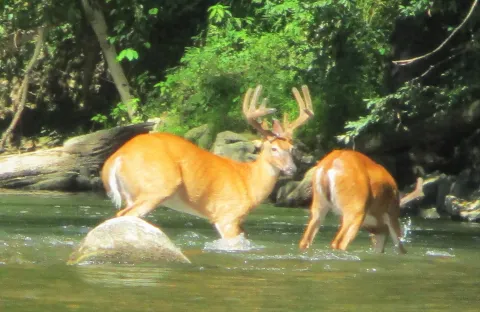White-Tailed Deer

By: Steve Roark
Volunteer, Cumberland Gap National Historical Park
The white-tailed deer (Odocoileus virginianus) is probably the favorite game species in our area, and spotting one always gives me a small touch of “wildness”. They have a complex and intriguing lifestyle.
The white-tail is in the family Cervidae, or deer family, which also includes elk and moose. A close relative to the white-tail is the mule deer, which only ranges in the West, while the more prolific white-tailed lives all across North America, only absent in the Southwest, northern Canada, and Alaska.
White-tailed deer are instantly identified when seen. They stand around four feet high at the shoulder and weighs 50 to 400 pounds. Their long thin legs give them great speed and agility. They are ruminants and feed hastily on vegetation usually at dusk and dawn, then return to cover where they regurgitate their food to more properly chew the cud in hidden safety.
Bedding areas for deer are secluded spots where they feel safe while inactive. At night they may use areas of heavy brush for cover, or dense evergreens for wind protection. During the day they may bed on ridges to allow them to see approaching predators. A southwest-facing slope provides added warmth in winter. Deer often use the same trails from feeding place to bedding spots, and these are easy to see in the woods. They may use these trails for years if food sources are dependable.
White-tails have a fairly fixed home range of 2 to 3 square miles, and normally have a routine pattern of movement through it. They are reluctant to leave their home range when chased by predators because once outside known territory there is a risk of getting trapped or slowed enough to endanger them. Females tend to keep to their home range, whereas bucks stay in one area from late winter to summer, and then roam more widely in the fall and early winter looking for does to mate with.
White-tail are herbivores, feeding on grass, leaves, small plants, and agricultural crops when available during the summer. In the fall they take advantage of abundant fruits and nuts. In winter they must depend on the twigs and bark of woody plants, collectively called browse. What deer feed on depends on the abundance and nutritional value of the plants, instinctively choosing the most nutritional species. In the spring deer continue to eat winter browse until new greenery returns.
- Log in to post comments